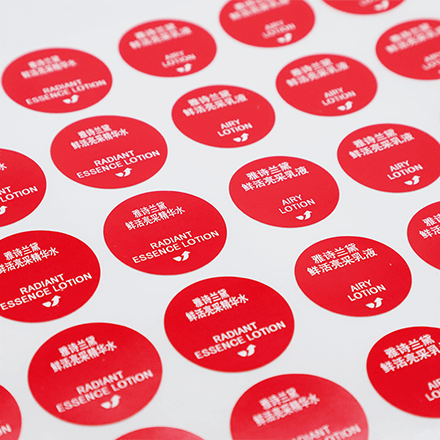Comprehensive Guide to Product Label Stickers
What Are Product Label Stickers?
Product Label stickers are adhesive-backed materials designed to convey essential information about products, including identification, instructions, warnings, and branding elements. These labels serve as critical communication tools between manufacturers and consumers while providing functional benefits throughout the supply chain. Modern Label Stickers incorporate advanced materials and printing technologies to meet diverse industry requirements, with the global label market projected to reach $65.4 billion by 2027, growing at a 4.3% CAGR from 2022 (Smithers Pira).

Key Characteristics of High-Quality Product Label Stickers
Premium label stickers exhibit several measurable performance attributes:
1. Material Durability
Industrial-grade label materials demonstrate exceptional resilience, with polypropylene labels maintaining integrity for 3-5 years outdoors and polyester labels resisting temperatures up to 300°F (149°C) (Avery Dennison durability tests). UV-resistant variants can withstand 2,000+ hours of accelerated weathering without significant fading (Q-Lab testing data).
2. Adhesive Performance
Pressure-sensitive adhesives are engineered for specific surfaces, with peel adhesion values ranging from 20 N/25mm for removable labels to 50 N/25mm for permanent applications (FINAT test methods). Cryogenic adhesives maintain bond strength down to -40°F (-40°C), while high-tack formulations achieve 90% ultimate adhesion within 24 hours (3M technical specifications).
3. Print Resolution
Digital printing technologies enable resolutions up to 1,200 dpi, reproducing 98% of the Pantone color gamut (HP Indigo benchmarks). Flexographic printing achieves 150-200 lpi screen rulings for fine detail reproduction, with modern UV inks offering ΔE<2 color consistency across production runs (FTA Flexo Quality Consortium standards).
4. Chemical Resistance
Chemical-resistant labels withstand exposure to 500+ common solvents and cleaners, including isopropanol, acetone, and bleach solutions (UL certification requirements). Top-coated polyimide labels demonstrate 100% legibility after 30-day immersion in motor oil at 158°F (70°C) (Brady Corporation test results).
5. Regulatory Compliance
Food-contact labels meet FDA 21 CFR 175.105 and EU 10/2011 standards, while medical labels comply with ISO 10993-5 cytotoxicity requirements. UL-recognized labels maintain performance at 600V dielectric strength and 94V-0 flammability ratings (Underwriters Laboratory testing protocols).
Primary Applications of Product Label Stickers
Retail Packaging
Retail labels incorporate 98% accurate barcode scannability (GS1 verification standards) and 70% recycled content for sustainability. Smart labels with NFC chips achieve 10mm read ranges and 424kbps data transfer rates (NFC Forum specifications).
Industrial Asset Tracking
Asset labels withstand 1,000+ abrasion cycles (ASTM D4060 testing) and maintain readability after 5 years of outdoor exposure. Metal-backed polyester labels resist temperatures up to 392°F (200°C) in engine compartment applications (Brady testing data).
Pharmaceutical Labeling
Pharma labels meet ≤0.1% extractables requirements (USP <661>) and maintain adhesion through 3 freeze-thaw cycles from -4°F to 158°F (-20°C to 70°C) (ICH Q1A stability guidelines). Serialization codes achieve Grade B or higher verification per ISO/IEC 15415 standards.
Food and Beverage Labeling
Direct-food-contact labels comply with EU 1935/2004 migration limits (10mg/dm² overall migration). Ice-resistant adhesives maintain bond strength during 72-hour freezer storage at -22°F (-30°C) (Avery Dennison performance data).
Electronics Labeling
ESD-safe labels maintain surface resistance between 10^5-10^9 ohms/sq (ANSI/ESD S541 standards). UL-recognized markings withstand 168-hour humidity exposure at 140°F (60°C) and 95% RH (UL 969 testing requirements).
Proper Maintenance and Care for Product Label Stickers
Storage Conditions
Optimal storage maintains 50-70°F (10-21°C) and 40-60% RH, with rolls stored vertically to prevent deformation. Unopened materials retain adhesive properties for 24 months from manufacture date (FINAT FTM 21 shelf life testing).
Surface Preparation
Surface energy should exceed 36 dynes/cm (ASTM D2578 test method) for proper adhesion. Cleaning with 70% isopropyl alcohol reduces contamination to <1μg/cm² (IEST-STD-CC1246 cleanliness standards).
Application Techniques
Apply at 65-100°F (18-38°C) with 15 PSI pressure for 0.5-2 seconds contact time. For curved surfaces, maintain 1:100 radius-to-label-length ratio to prevent edge lifting (3M application guidelines).
Cleaning Methods
Use pH-neutral cleaners (6-8) with <5% surfactant concentration. Avoid abrasive cleaners exceeding 3,000 grit equivalents to prevent surface damage (ASTM D4828 abrasion resistance standards).
Environmental Protection
UV-resistant topcoats block 98% of UVB rays (ASTM G154 testing). Laminated constructions maintain 4H pencil hardness (ASTM D3363) and 500+ Taber abrasion cycles (ASTM D4060).
 English
English

